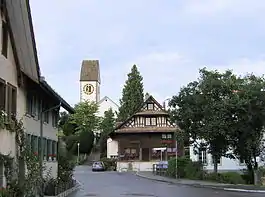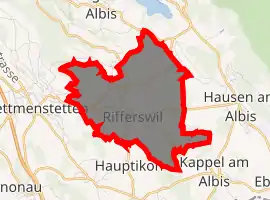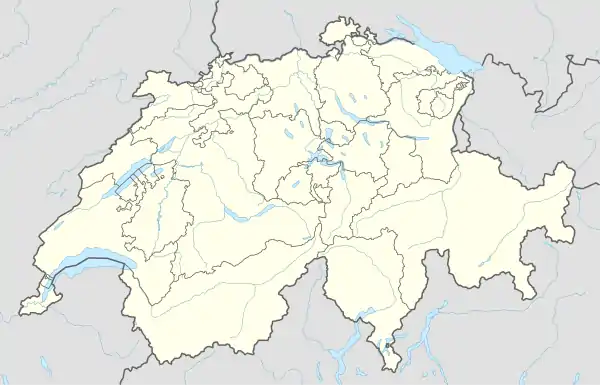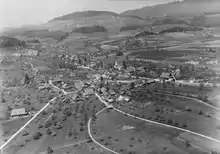Rifferswil
Rifferswil is a village in the district of Affoltern in the canton of Zürich in Switzerland.
Rifferswil | |
|---|---|
 | |
 Coat of arms | |
Location of Rifferswil 
| |
 Rifferswil  Rifferswil | |
| Coordinates: 47°14′N 8°28′E | |
| Country | Switzerland |
| Canton | Zurich |
| District | Affoltern |
| Area | |
| • Total | 6.50 km2 (2.51 sq mi) |
| Elevation | 579 m (1,900 ft) |
| Population (2018-12-31)[2] | |
| • Total | 1,123 |
| • Density | 170/km2 (450/sq mi) |
| Time zone | UTC+01:00 (Central European Time) |
| • Summer (DST) | UTC+02:00 (Central European Summer Time) |
| Postal code(s) | 8911 |
| SFOS number | 0012 |
| Surrounded by | Aeugst am Albis, Hausen am Albis, Kappel am Albis, Mettmenstetten |
| Website | www SFSO statistics |
Geography

Rifferswil has an area of 6.6 km2 (2.5 sq mi). Of this area, 66.4% is used for agricultural purposes, while 22.7% is forested. Of the rest of the land, 9% is settled (buildings or roads) and the remainder (2%) is non-productive (rivers, glaciers or mountains).[3]
Demographics
Rifferswil has a population (as of 31 December 2019) of 1,129.[4] As of 2007, 5.7% of the population was made up of foreign nationals. Over the last 10 years the population has grown at a rate of 14%. Most of the population (as of 2000) speaks German (97.5%), with French being second most common ( 0.7%) and Italian being third ( 0.4%).
In the 2007 election the most popular party was the SVP which received 32.7% of the vote. The next three most popular parties were the SPS (22.8%), the Green Party (14.8%) and the CSP (14%).
The age distribution of the population (as of 2000) is children and teenagers (0–19 years old) make up 28.6% of the population, while adults (20–64 years old) make up 58.4% and seniors (over 64 years old) make up 13%. In Rifferswil about 88.5% of the population (between age 25-64) have completed either non-mandatory upper secondary education or additional higher education (either university or a Fachhochschule).
Rifferswil has an unemployment rate of 1.59%. As of 2005, there were 58 people employed in the primary economic sector and about 21 businesses involved in this sector. 67 people are employed in the secondary sector and there are 15 businesses in this sector. 61 people are employed in the tertiary sector, with 21 businesses in this sector.[3]
References
- "Arealstatistik Standard - Gemeinden nach 4 Hauptbereichen". Federal Statistical Office. Retrieved 13 January 2019.
- "Ständige Wohnbevölkerung nach Staatsangehörigkeitskategorie Geschlecht und Gemeinde; Provisorische Jahresergebnisse; 2018". Federal Statistical Office. 9 April 2019. Retrieved 11 April 2019.
- Swiss Federal Statistical Office accessed 24-Jul-2009
- "Ständige und nichtständige Wohnbevölkerung nach institutionellen Gliederungen, Geburtsort und Staatsangehörigkeit". bfs.admin.ch (in German). Swiss Federal Statistical Office - STAT-TAB. 31 December 2019. Retrieved 6 October 2020.
